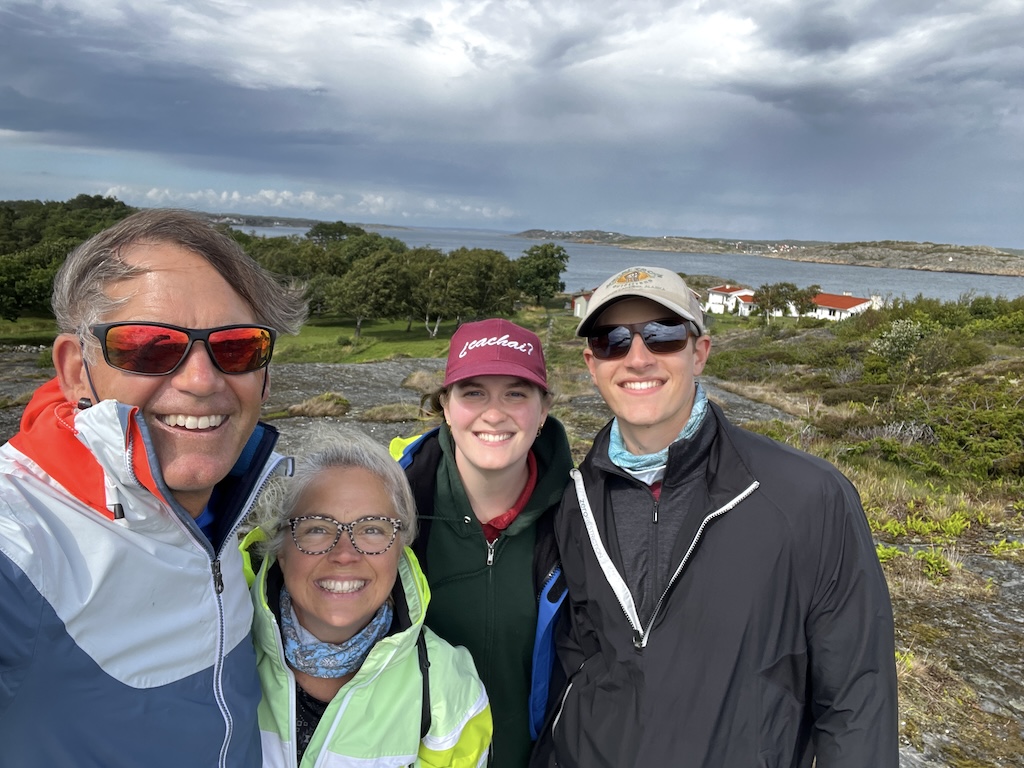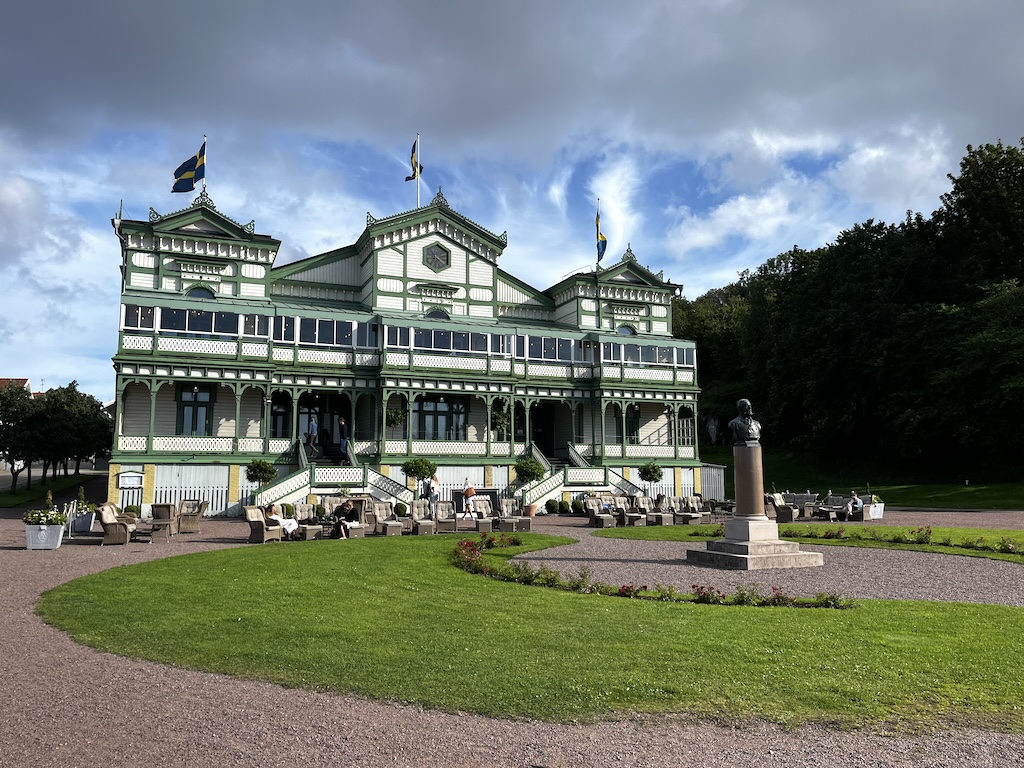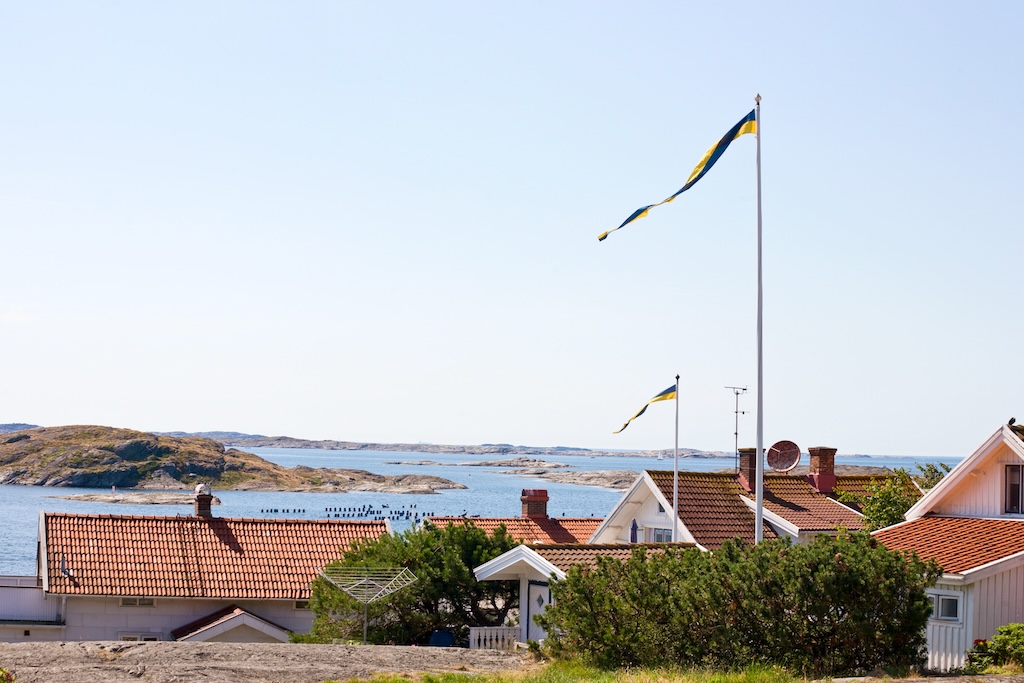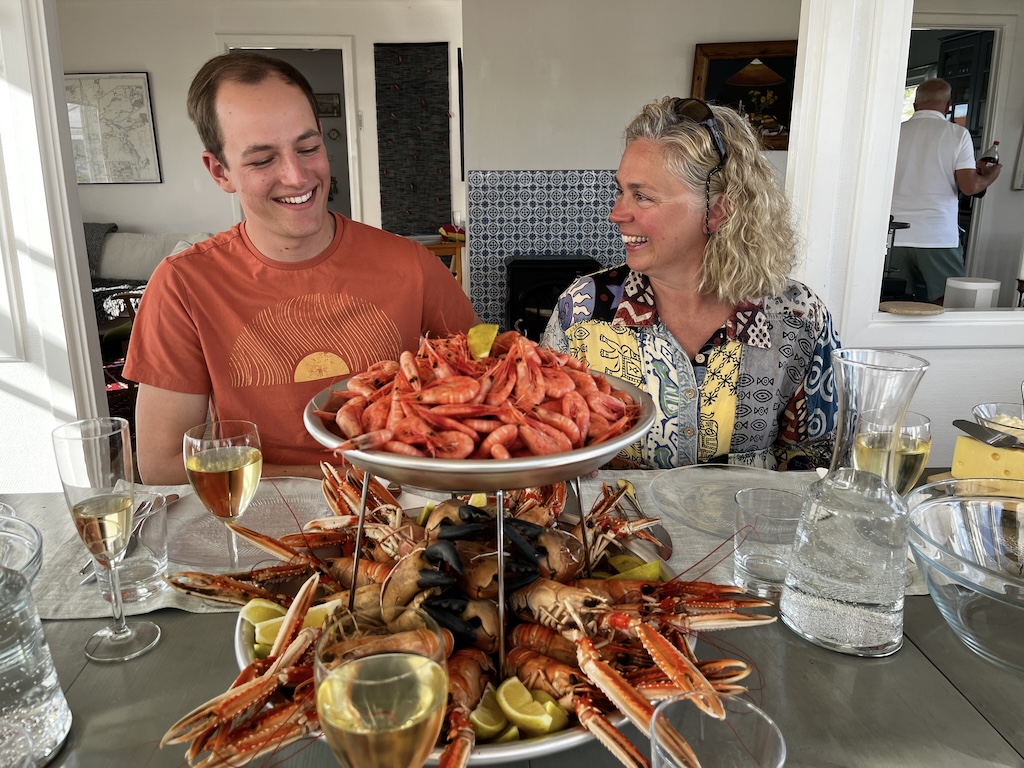Gothenburg (pronounced ‘YOAT-a-bore-ee’) is to the west coast of Sweden what Stockholm is to the east. It has all of the big city hub-bub you would expect – tall buildings in the city center surrounded by sprawling residential neighborhoods, a thriving economy, and with its location on the North Sea, a bustling waterfront for both big ships and small craft. Just offshore is the renowned Gothenburg archipelago with a dizzying array of tiny rocky islands – some sparsely populated with holiday homes, others in their natural unpopulated state. With the wealth in the area, pleasure boating and racing is very popular in the summer months. As we pulled into the GKSS marina in mid-July, we began to regret not making a reservation ahead of time as we circled the docks looking for a small green flag hidden low to the water indicating that the space was available. We were here a few days early before meeting up with my nephew Peter and is girlfriend Bianca, both newly graduated from college. Despite their better judgement they had left a wedding in sunny Santorini to join us for a sail around the Swedish archipelago in what was forecasted to be a week of high winds and rain. But first, we had a not-insignificant list of projects to do and purchases to make in an attempt to leverage one of our last calls at a large city for a while.
With only our two feet to get around, we are often at the mercy of a city’s transportation system to run errands and find provisions. And Gothenburg rolled out the red carpet for us. Just a refreshing 5 minute walk from the marina is a stop on the tram line running from the suburbs into downtown. Two stops away was one of the most well stocked chandleries I had seen since leaving France. One big task I had was the upgrade of our engine alternator, for improved battery charging. I had brought most of the parts from the U.S., but having a chandlery so close was perfect to manage the inevitable unexpected surprises. Fixing our propane cooking system took more creativity and I criss-crossed on transit to nearly all corners of the city. I look forward to the day when we can have an induction stove, but until then we have to put up with the constantly changing standards for propane tanks and fittings to fry up our morning eggs and the other magical dishes that come forth from the galley. On my first outing, I took our empty tank from gas station to gas station, each time receiving a sad swinging of the head from side to side. I eventually resigned to buying a nice new fiberglass built tank that came full of gas. The gas station attendant was very patient and helpful with me when I tried to figure out how to plumb our existing line to this new tank. She didn’t have the right fitting, but directed me to a ‘big box’ home improvement store on the outskirts of Gothenburg. Lucky for me, a bus stop was just across the street and the bus arrived to pick me up within five minutes, dropping me off across the street from a big suburban shopping mall. I would normally not let myself be caught dead near one of these American export eye sores, but when you are desperate for the right part, idealism goes out the window. They didn’t have the part but referred me to another home improvement store completely on the other side of Gothenburg. I hopped on another bus that came within five minutes, with my full explosive tank of propane gas in hand without any drivers or passengers showing any apparent sign of disdain. To my delight, this store had the exact hose and fitting I needed, and back I went on another promptly arriving, conveniently located bus. It had taken all afternoon, but would have been much longer if Gothenburg had not invested in such fantastic transportation infrastructure.



My nephew Peter had been onboard Sea Rose once before, back in the placid warm waters of Croatia. The heavy rain and 30 knot gusts as we motored out through the Gothenburg shipping channel was going to be a test of his determination, and possibly the strength of his relationship with his girlfriend Bianca! If this was their audition, they passed with flying colors as we settled into a protected area in the lee of Grötö island. Here, locals turned down the opportunity to have a bridge built from the mainland, choosing a different strategy than their many neighboring islands, as they sought a quieter life in this rugged, rocky outpost.

In most parts of the Gothenburg archipelago, there are multiple inside routes to travel along the coast, giving one an extra layer of protection from the big swells whipped up by onshore winds. If it’s rough, you go inside; if it’s calmer, you have the option to go outside. The outside routes are especially helpful for longer hops as you can avoid the mind-strain of constantly watching and steering to avoid rocks that are as plentiful as eggs at Easter. We chose the inside option, with plenty of wind to still fill our sails.
Our ultimate destination was the town of Marstrand, with an overnight first at the remote little bay of Utkäften. We were striving for a mix of nature and the environment to balance out the times we would be spending around people and progress. But Utkäften was a little too close to nature. As we doused sails and approached the narrowing cut in the shore, the swells from out in the North Sea were finding their way around the headlands and were curving into an anchorage that was, even if the waters were calm, probably still too tight for us to swing in. Some things look better on paper than in reality. We dropped the hook to have some lunch and make sure we were giving the anchorage the proper consideration it deserved, as the location and the options to rock hop on shore looked pretty tremendous. It was the shortest lunch we had all week.

Marstrand was just around the corner and, after fighting through more rough water and close navigation around rocky skerries, we soon had the wind to our back and a large marina with boats jockeying here and there to get into the best dock space. We had heard that Marstrand was worthy of an extra long look-see, and the reasons were readily apparent. Waterfront buildings with an old world charm lined the main street. Restaurants spilled out into the sidewalks. Striking architecture that brought forth bygone images of men in long coats and top hats with long-gowned women on their arm strolling casually reminded me of a period piece out of Hollywood. A small passenger ferry from the mainland seemed to symbolically separate this stately society from all the stress and confusion of mainstream society, dropping passengers at a wharf that demarcated a life–or at least an afternoon–of leisure. A stop at the Societetshuset for an pre-dinner beverage seemed to be a foregone conclusion.

Growing up in this extreme of a climate, Swedes seem to take great pride in their collective rugged character – indeed their continued survival. Or, perhaps those with less fortitude have chosen to emigrate closer to the equator. As the sun left long shadows on the shore, countless groups of boisterous men and women clad in minimal swimwear braved the cold temperatures for an evening dip in the North Sea. We all murmured an interest in a morning swim with as much enthusiasm as this year’s Boston Red Sox fans. That is, all of us except Peter who, upon the completion of dinner, found a landmark venue adjacent to the Strandverket castle for a dive in the water. We would have all jumped in with him were it not for our critical, irreplaceable roles: Bianca to hold his towel, Karen to watch out for boat traffic, and me to fly the drone, of course!

Fifteen nm further up the coast and still along the inside route, we passed the seaside hamlet of Kyrkesund. This was the kind of respite perfect for a budding author looking for inspiration or, perhaps, an excuse to put the pen down as a trifecta of blue sky, sparkling water, and the passing a small craft graced the rustic town wharf.



The inland route meanders its way beyond Kyrkesund a few miles further where we planned to stop for the night. But, as we learned back at Utkäften, it’s good to have a plan B. Here, tall metal towers on either end of the shore held up high tension power lines, a distraction from the visual attraction. These power lines spanned a large bay that opened up towards the interior, drawing us in by the prospect of calm winds and placid waters. Sure enough, we found that and more as we snuggled up to a vertical granite rock as our overnight mooring option–the only one left in the already packed little anchorage of Kälkerön. We had seen plenty of pictures of Swedes docking their delicate fiberglass sailboats right up to big slabs of rock like this and I had prayed that we’d never have to contemplate such a crazy risk. The wake of just one passing powerboat at speed might grind our hull to bits against such an unforgiving substitute of a dock. Well, here we were and we had to make the best of it. In the end, with a commitment from all of our fenders to do their job to the best of their ability, and the able hands of youth to scramble up the rock wall to secure our lines, we were more secure than we had been so far this summer. Even my tachycardia at the sight of uneven granite just a foot away from the porthole started to settle down to the simple uneasiness that comes with new accommodations!




Our week in the delightful company of Peter and Bianca was coming to a close as we headed north to the town of Gullholmen. It felt like we were sailing through a jewelry store of gem-like beauty. First Marstrand, then Kyrkesund, and now Gullholmen. With a steady breeze on our beam, we sailed along briskly with just the jib up and passed the helm to the younger kin to give them firsthand experience dodging rocks, shallows and other boats.

Gullholmen, like Marstrand, stands a short ferry-ride offshore of the mainland. In fact, one can buy a bus ticket in Gothenburg and ride the city bus all the way to the ferry landing and use the same ticket to cross to Gullholmen – such is the incredible breadth of the Gothenburg public transit system.


Once on the island, and having explored all of the historical sites, a simple footbridge connects one to an even smaller islet where even more history was made amongst tiny fishing cottages clustered together with only room for a wheeled cart to pass between the walls of the stone houses. It was thought that this design approach not only made better use of the limited land but also brought mutual protection against high winds and storms.
We had also chosen Gullholmen as the closest harbor to family members of a Swedish couple we knew from back home. In Stocken, a quick drive from the ferry landing, we were treated to equal heaping portions of delicious seafood and insights into the Swedish culture, as only a meal in the home of a local can reveal. It is no secret that although Sweden is a democracy, its approach to managing a country is vastly different from America’s democracy. And it should be no surprise that our hosts, Mikael and Lena, were very proud of their country. At times, insights were coming as fast as the proverbial fire hose, but here were a few notable nuggets:
- Every man’s right or Allemansrätten. Sometimes referred to as ‘common mans law’, this right grants individuals the freedom to wander just about anywhere they want throughout the countryside, even through other’s land. It is even allowable to camp there, as long as respect is shown to the landowners, animals and the environment.
- Open doors. For the entire dinner, Mikael and Lena kept their front door wide open. At first I thought they were letting the fresh air pass through, but it wasn’t a particularly hot day. Then I thought they might be wanting to send a message to their neighbors, like ‘We are home, we hope you will stop in for a visit.’ For sure, it sent a message that crime was not a concern.
- Pennant flag. When I mentioned to Lena how beautiful it is to see all of the Swedish pennant flags (the long skinny streamers in the Swedish colors), she explained it is customary to use the pennant as a sign that you are home. My ‘life-in-a-bigger-city’ mindset immediately thought how easy of a mark this would make for a burglar in a time crunch, but then again I don’t leave my door wide open either.

- Social contract. The social programs so popular with Swedes – free university, free healthcare, ample maternity/paternity leave, and the like – were framed by Mikael in a way that I had not previously heard. While many of us might assume that this is simply a society that chooses to spend lavishly on free stuff for their younger neighbors, there is an implied contract that comes with it, a kind of social pressure from your peers. The government will give you a head start on education and starting a family, but you are expected to use these gifts to gain employment and be a responsible member of society. If you don’t, you are looked down upon. Which brings us to the shrimp sandwich. Mikael proceeded to explain the Swedish phrase ‘att glida in på en räkmacka’, literally meaning ‘to slide in on a shrimp sandwich’. Or, basically, someone who didn’t need to work to get to where they are –a free-loader. As we slathered up handfuls of shrimp off their generous platter, I hoped the Swedes would look kindly on my many years of earlier employment!



Wow! That photo of the seafood feast was amazing!
Your granite rock mooring had me gulping!
Sounds like it was a wonderful visit.
What a beautiful telling of your adventures. Thank you so much for the time that you put in to share this with us—you are definitely not sliding in on a shrimp sandwich!
Thank you Cynthia, glad you liked the blog entry! The Swedes are some of the kindest people you can meet, and perhaps due in part to their sense of humor!